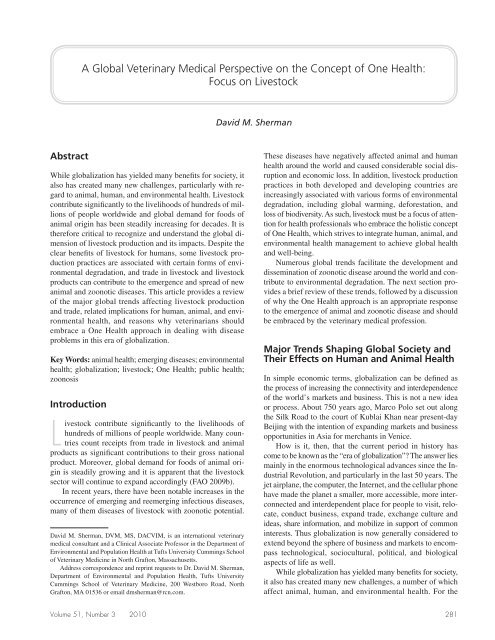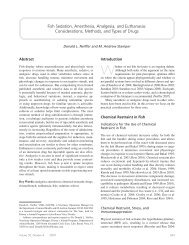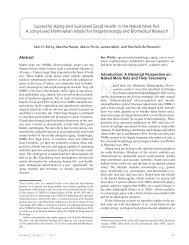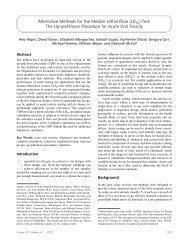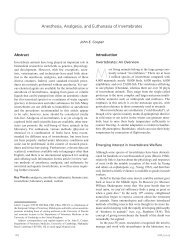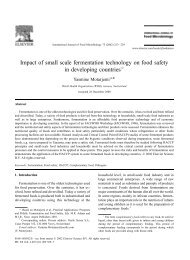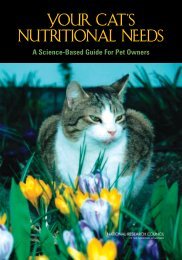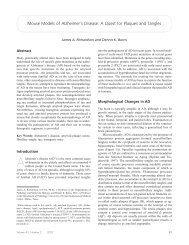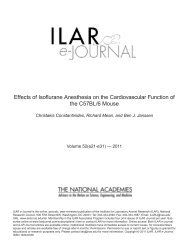A Global Veterinary Medical Perspective on the Concept of One ...
A Global Veterinary Medical Perspective on the Concept of One ...
A Global Veterinary Medical Perspective on the Concept of One ...
Create successful ePaper yourself
Turn your PDF publications into a flip-book with our unique Google optimized e-Paper software.
Abstract<br />
While globalizati<strong>on</strong> has yielded many benefi ts for society, it<br />
also has created many new challenges, particularly with regard<br />
to animal, human, and envir<strong>on</strong>mental health. Livestock<br />
c<strong>on</strong>tribute signifi cantly to <strong>the</strong> livelihoods <strong>of</strong> hundreds <strong>of</strong> milli<strong>on</strong>s<br />
<strong>of</strong> people worldwide and global demand for foods <strong>of</strong><br />
animal origin has been steadily increasing for decades. It is<br />
<strong>the</strong>refore critical to recognize and understand <strong>the</strong> global dimensi<strong>on</strong><br />
<strong>of</strong> livestock producti<strong>on</strong> and its impacts. Despite <strong>the</strong><br />
clear benefi ts <strong>of</strong> livestock for humans, some livestock producti<strong>on</strong><br />
practices are associated with certain forms <strong>of</strong> envir<strong>on</strong>mental<br />
degradati<strong>on</strong>, and trade in livestock and livestock<br />
products can c<strong>on</strong>tribute to <strong>the</strong> emergence and spread <strong>of</strong> new<br />
animal and zo<strong>on</strong>otic diseases. This article provides a review<br />
<strong>of</strong> <strong>the</strong> major global trends affecting livestock producti<strong>on</strong><br />
and trade, related implicati<strong>on</strong>s for human, animal, and envir<strong>on</strong>mental<br />
health, and reas<strong>on</strong>s why veterinarians should<br />
embrace a <strong>One</strong> Health approach in dealing with disease<br />
problems in this era <strong>of</strong> globalizati<strong>on</strong>.<br />
Key Words: animal health; emerging diseases; envir<strong>on</strong>mental<br />
health; globalizati<strong>on</strong>; livestock; <strong>One</strong> Health; public health;<br />
zo<strong>on</strong>osis<br />
Introducti<strong>on</strong><br />
A <str<strong>on</strong>g>Global</str<strong>on</strong>g> <str<strong>on</strong>g>Veterinary</str<strong>on</strong>g> <str<strong>on</strong>g>Medical</str<strong>on</strong>g> <str<strong>on</strong>g>Perspective</str<strong>on</strong>g> <strong>on</strong> <strong>the</strong> C<strong>on</strong>cept <strong>of</strong> <strong>One</strong> Health:<br />
Focus <strong>on</strong> Livestock<br />
Livestock c<strong>on</strong>tribute signifi cantly to <strong>the</strong> livelihoods <strong>of</strong><br />
hundreds <strong>of</strong> milli<strong>on</strong>s <strong>of</strong> people worldwide. Many countries<br />
count receipts from trade in livestock and animal<br />
products as signifi cant c<strong>on</strong>tributi<strong>on</strong>s to <strong>the</strong>ir gross nati<strong>on</strong>al<br />
product. Moreover, global demand for foods <strong>of</strong> animal origin<br />
is steadily growing and it is apparent that <strong>the</strong> livestock<br />
sector will c<strong>on</strong>tinue to expand accordingly (FAO 2009b).<br />
In recent years, <strong>the</strong>re have been notable increases in <strong>the</strong><br />
occurrence <strong>of</strong> emerging and reemerging infectious diseases,<br />
many <strong>of</strong> <strong>the</strong>m diseases <strong>of</strong> livestock with zo<strong>on</strong>otic potential.<br />
David M. Sherman, DVM, MS, DACVIM, is an internati<strong>on</strong>al veterinary<br />
medical c<strong>on</strong>sultant and a Clinical Associate Pr<strong>of</strong>essor in <strong>the</strong> Department <strong>of</strong><br />
Envir<strong>on</strong>mental and Populati<strong>on</strong> Health at Tufts University Cummings School<br />
<strong>of</strong> <str<strong>on</strong>g>Veterinary</str<strong>on</strong>g> Medicine in North Graft<strong>on</strong>, Massachusetts.<br />
Address corresp<strong>on</strong>dence and reprint requests to Dr. David M. Sherman,<br />
Department <strong>of</strong> Envir<strong>on</strong>mental and Populati<strong>on</strong> Health, Tufts University<br />
Cummings School <strong>of</strong> <str<strong>on</strong>g>Veterinary</str<strong>on</strong>g> Medicine, 200 Westboro Road, North<br />
Graft<strong>on</strong>, MA 01536 or email dmsherman@rcn.com.<br />
David M. Sherman<br />
These diseases have negatively affected animal and human<br />
health around <strong>the</strong> world and caused c<strong>on</strong>siderable social disrupti<strong>on</strong><br />
and ec<strong>on</strong>omic loss. In additi<strong>on</strong>, livestock producti<strong>on</strong><br />
practices in both developed and developing countries are<br />
increasingly associated with various forms <strong>of</strong> envir<strong>on</strong>mental<br />
degradati<strong>on</strong>, including global warming, deforestati<strong>on</strong>, and<br />
loss <strong>of</strong> biodiversity. As such, livestock must be a focus <strong>of</strong> attenti<strong>on</strong><br />
for health pr<strong>of</strong>essi<strong>on</strong>als who embrace <strong>the</strong> holistic c<strong>on</strong>cept<br />
<strong>of</strong> <strong>One</strong> Health, which strives to integrate human, animal, and<br />
envir<strong>on</strong>mental health management to achieve global health<br />
and well-being.<br />
Numerous global trends facilitate <strong>the</strong> development and<br />
disseminati<strong>on</strong> <strong>of</strong> zo<strong>on</strong>otic disease around <strong>the</strong> world and c<strong>on</strong>tribute<br />
to envir<strong>on</strong>mental degradati<strong>on</strong>. The next secti<strong>on</strong> provides<br />
a brief review <strong>of</strong> <strong>the</strong>se trends, followed by a discussi<strong>on</strong><br />
<strong>of</strong> why <strong>the</strong> <strong>One</strong> Health approach is an appropriate resp<strong>on</strong>se<br />
to <strong>the</strong> emergence <strong>of</strong> animal and zo<strong>on</strong>otic disease and should<br />
be embraced by <strong>the</strong> veterinary medical pr<strong>of</strong>essi<strong>on</strong>.<br />
Major Trends Shaping <str<strong>on</strong>g>Global</str<strong>on</strong>g> Society and<br />
Their Effects <strong>on</strong> Human and Animal Health<br />
In simple ec<strong>on</strong>omic terms, globalizati<strong>on</strong> can be defi ned as<br />
<strong>the</strong> process <strong>of</strong> increasing <strong>the</strong> c<strong>on</strong>nectivity and interdependence<br />
<strong>of</strong> <strong>the</strong> world’s markets and business. This is not a new idea<br />
or process. About 750 years ago, Marco Polo set out al<strong>on</strong>g<br />
<strong>the</strong> Silk Road to <strong>the</strong> court <strong>of</strong> Kublai Khan near present-day<br />
Beijing with <strong>the</strong> intenti<strong>on</strong> <strong>of</strong> expanding markets and business<br />
opportunities in Asia for merchants in Venice.<br />
How is it, <strong>the</strong>n, that <strong>the</strong> current period in history has<br />
come to be known as <strong>the</strong> “era <strong>of</strong> globalizati<strong>on</strong>”? The answer lies<br />
mainly in <strong>the</strong> enormous technological advances since <strong>the</strong> Industrial<br />
Revoluti<strong>on</strong>, and particularly in <strong>the</strong> last 50 years. The<br />
jet airplane, <strong>the</strong> computer, <strong>the</strong> Internet, and <strong>the</strong> cellular ph<strong>on</strong>e<br />
have made <strong>the</strong> planet a smaller, more accessible, more interc<strong>on</strong>nected<br />
and interdependent place for people to visit, relocate,<br />
c<strong>on</strong>duct business, expand trade, exchange culture and<br />
ideas, share informati<strong>on</strong>, and mobilize in support <strong>of</strong> comm<strong>on</strong><br />
interests. Thus globalizati<strong>on</strong> is now generally c<strong>on</strong>sidered to<br />
extend bey<strong>on</strong>d <strong>the</strong> sphere <strong>of</strong> business and markets to encompass<br />
technological, sociocultural, political, and biological<br />
aspects <strong>of</strong> life as well.<br />
While globalizati<strong>on</strong> has yielded many benefi ts for society,<br />
it also has created many new challenges, a number <strong>of</strong> which<br />
affect animal, human, and envir<strong>on</strong>mental health. For <strong>the</strong><br />
Volume 51, Number 3 2010 281
veterinary medical pr<strong>of</strong>essi<strong>on</strong> to optimize its usefulness in<br />
<strong>the</strong>se times, veterinarians must understand <strong>the</strong> important<br />
global trends affecting health and disease and develop <strong>the</strong><br />
knowledge, tools, and skills to resp<strong>on</strong>d effectively to <strong>the</strong>se<br />
challenges.<br />
Emerging Animal Diseases and Zo<strong>on</strong>oses<br />
By <strong>the</strong> mid-20 th century, with <strong>the</strong> development <strong>of</strong> effective<br />
antibiotics and vaccines well advanced, <strong>the</strong>re was a prevailing<br />
attitude am<strong>on</strong>g health pr<strong>of</strong>essi<strong>on</strong>als that <strong>the</strong> scourge <strong>of</strong> infectious<br />
disease had largely been c<strong>on</strong>quered and <strong>the</strong> focus <strong>of</strong><br />
medicine could be shifted to neoplastic, cardiovascular, and<br />
o<strong>the</strong>r n<strong>on</strong>infectious categories <strong>of</strong> disease. Quite <strong>the</strong> c<strong>on</strong>trary,<br />
however, <strong>the</strong> current period is characterized by not <strong>on</strong>ly <strong>the</strong><br />
emergence <strong>of</strong> new infectious diseases <strong>of</strong> animals and humans<br />
but also <strong>the</strong> reemergence <strong>of</strong> diseases previously thought to be<br />
under c<strong>on</strong>trol, such as tuberculosis.<br />
Studies report that 64% <strong>of</strong> 1,400 known human pathogens<br />
(Heeney 2006) and 73% <strong>of</strong> emerging human pathogens are<br />
zo<strong>on</strong>otic (Woolhouse and Gowtage-Sequeria 2005). These include<br />
many infecti<strong>on</strong>s with global reach such as human immunodefi<br />
ciency virus (HIV), severe acute respiratory syndrome<br />
(SARS), West Nile virus, highly pathogenic avian infl uenza<br />
H5N1, and <strong>the</strong> more recently identifi ed infl uenza virus, H1N1.<br />
There are multiple, complex reas<strong>on</strong>s for this emergence (Brown<br />
2004; Morse 2004), including <strong>the</strong> movement <strong>of</strong> pathogens<br />
through modern jet travel, landscape transformati<strong>on</strong>s that result<br />
in closer c<strong>on</strong>tact between wildlife and humans, <strong>the</strong> intensifi<br />
cati<strong>on</strong> <strong>of</strong> livestock producti<strong>on</strong>, <strong>the</strong> raising <strong>of</strong> livestock<br />
and poultry in close associati<strong>on</strong> with people, inadequate biosecurity<br />
in livestock management, and <strong>the</strong> development <strong>of</strong><br />
antibiotic resistance in some bacterial diseases. Some <strong>of</strong><br />
<strong>the</strong>se are described in <strong>the</strong> following secti<strong>on</strong>s; recent reports<br />
provide fur<strong>the</strong>r informati<strong>on</strong> (FAO 2009a, 75-93; J<strong>on</strong>es et al.<br />
2008; Patz et al. 2004; PCIFAP 2008, 10-29; Snowden 2008;<br />
Weiss and McMichael 2004; Wolfe et al. 2007).<br />
High-Speed Transportati<strong>on</strong> and<br />
Communicati<strong>on</strong><br />
Modern jet travel now allows passengers to move from virtually<br />
any place in <strong>the</strong> world to any o<strong>the</strong>r place within 36 hours—<br />
less than <strong>the</strong> incubati<strong>on</strong> period <strong>of</strong> many viral and bacterial<br />
diseases. This means that infecti<strong>on</strong>s can become globally<br />
disseminated before clinical disease is recognized. The SARS<br />
outbreak <strong>of</strong> 2003, which quickly spread to 29 countries, and<br />
<strong>the</strong> <strong>on</strong>going, novel H1N1 infl uenza pandemic (see Pappaioanou<br />
and Gramer 2010 in this issue) dramatically underscore this<br />
point. As such, <strong>the</strong> noti<strong>on</strong> <strong>of</strong> “foreign” or “exotic” diseases<br />
has become less meaningful. A wide range <strong>of</strong> diseases now<br />
have <strong>the</strong> potential to crop up unexpectedly anywhere in <strong>the</strong><br />
world and some may quickly become endemic; for example,<br />
West Nile virus infecti<strong>on</strong> was unknown in North America<br />
before 1999 but is now fi rmly established <strong>on</strong> much <strong>of</strong> <strong>the</strong><br />
c<strong>on</strong>tinent.<br />
As <strong>the</strong>se examples indicate, health pr<strong>of</strong>essi<strong>on</strong>als, including<br />
veterinarians, must be familiar with <strong>the</strong> epidemiology and<br />
clinical signs <strong>of</strong> a broad range <strong>of</strong> infectious diseases that may<br />
not be—for <strong>the</strong> moment—present in <strong>the</strong>ir countries. This <strong>of</strong><br />
course includes <strong>the</strong> highly c<strong>on</strong>tagious diseases <strong>of</strong> livestock<br />
and poultry such as foot and mouth disease, peste des petits<br />
ruminants, African swine fever, Newcastle disease, and highly<br />
pathogenic avian infl uenza, to name but a few.<br />
Modern communicati<strong>on</strong> has facilitated <strong>the</strong> rapid disseminati<strong>on</strong><br />
<strong>of</strong> informati<strong>on</strong>, both scientifi c and journalistic, about<br />
disease occurrence; <strong>the</strong> World Animal Health Informati<strong>on</strong> System<br />
(OIE 2010) and <strong>the</strong> Internati<strong>on</strong>al Society for Infectious<br />
Diseases’ ProMED-mail service (ISID 2010) are two examples<br />
<strong>of</strong> such sources. This informati<strong>on</strong> allows regulatory veterinarians<br />
to better understand emerging disease patterns and<br />
act more quickly to initiate disease investigati<strong>on</strong> and c<strong>on</strong>trol<br />
efforts. It also raises public expectati<strong>on</strong>s that <strong>of</strong>fi cials will<br />
move quickly to initiate c<strong>on</strong>trol efforts. Intense media coverage<br />
and high public expectati<strong>on</strong>s mean that regulatory veterinarians<br />
must have effective disease c<strong>on</strong>trol plans in place<br />
that are adequately resourced and that <strong>the</strong>y can communicate<br />
risk to <strong>the</strong> public clearly and effectively. But such communicati<strong>on</strong>s<br />
can also have serious adverse effects <strong>on</strong> c<strong>on</strong>sumer<br />
percepti<strong>on</strong>s <strong>of</strong> <strong>the</strong> wholesomeness <strong>of</strong> animal source foods,<br />
with disastrous ec<strong>on</strong>omic c<strong>on</strong>sequences for producers. Such<br />
extensive media coverage increases <strong>the</strong> need for proper, resp<strong>on</strong>sible,<br />
effective risk communicati<strong>on</strong> by respected authorities<br />
(also see Decker et al. 2010 in this issue).<br />
Growth in Internati<strong>on</strong>al Trade<br />
Internati<strong>on</strong>al trade has grown dramatically since World War II.<br />
That growth has been facilitated by internati<strong>on</strong>al efforts to break<br />
down trade barriers and to create a level playing fi eld for all<br />
trading partners through free market initiatives formalized<br />
through <strong>the</strong> World Trade Organizati<strong>on</strong> (WTO) in <strong>the</strong> 1990s.<br />
Growth in <strong>the</strong> trade <strong>of</strong> livestock and foods <strong>of</strong> animal origin has<br />
been particularly robust as a result <strong>of</strong> several factors: <strong>the</strong> eliminati<strong>on</strong><br />
or reducti<strong>on</strong> <strong>of</strong> tariffs associated with free-market<br />
reforms; technological advances in c<strong>on</strong>tainerized and refrigerated<br />
shipping; and a steadily increasing global c<strong>on</strong>sumer<br />
demand for foods <strong>of</strong> animal origin, associated with ec<strong>on</strong>omic<br />
growth and increasing prosperity, particularly in developing<br />
countries. Since 1960, global meat producti<strong>on</strong> has more than<br />
tripled, milk producti<strong>on</strong> has nearly doubled, and egg producti<strong>on</strong><br />
has increased almost fourfold. <str<strong>on</strong>g>Global</str<strong>on</strong>g> producti<strong>on</strong> and c<strong>on</strong>sumpti<strong>on</strong><br />
<strong>of</strong> meat will likely c<strong>on</strong>tinue to rise, from 233 milli<strong>on</strong> metric<br />
t<strong>on</strong>s (Mt) in 2000 to 300 milli<strong>on</strong> in 2020, as will that <strong>of</strong> milk,<br />
from 568 to 700 milli<strong>on</strong> Mt over <strong>the</strong> same period. Egg producti<strong>on</strong><br />
will also increase by 30% (Speedy 2003).<br />
The increased movement <strong>of</strong> live animals and animal products<br />
corresp<strong>on</strong>ds to an increased risk in <strong>the</strong> spread <strong>of</strong> transboundary<br />
diseases <strong>of</strong> animals as well as zo<strong>on</strong>otic diseases,<br />
particularly foodborne diseases. As such, <strong>the</strong> WTO has actively<br />
promoted <strong>the</strong> development <strong>of</strong> regulati<strong>on</strong>s and policies to ensure<br />
that animal health and food safety are c<strong>on</strong>sidered and<br />
282 ILAR Journal
protected as core elements in internati<strong>on</strong>al trade. The World<br />
Organizati<strong>on</strong> for Animal Health (OIE) provides scientifi c<br />
expertise to WTO for regulating trade in livestock while <strong>the</strong><br />
Food and Agricultural Organizati<strong>on</strong> <strong>of</strong> <strong>the</strong> United Nati<strong>on</strong>s<br />
(FAO) and World Health Organizati<strong>on</strong> (WHO), through <strong>the</strong><br />
Codex Alimentarius (www.codexalimentarius.net), provide<br />
guidelines for <strong>the</strong> regulati<strong>on</strong> <strong>of</strong> food products, including foods<br />
<strong>of</strong> animal origin.<br />
War and Terrorism<br />
In <strong>the</strong> past 30 years, <strong>the</strong> dominant form <strong>of</strong> armed c<strong>on</strong>fl ict has<br />
shifted from wars between nati<strong>on</strong>s to c<strong>on</strong>fl icts within nati<strong>on</strong>s,<br />
or civil wars. At <strong>the</strong> beginning <strong>of</strong> 2008, for example, <strong>the</strong>re were<br />
26 active armed c<strong>on</strong>fl icts worldwide, all <strong>of</strong> <strong>the</strong>m civil c<strong>on</strong>fl icts<br />
between <strong>the</strong> government <strong>of</strong> a state, <strong>on</strong> <strong>the</strong> <strong>on</strong>e hand, and at least<br />
<strong>on</strong>e internal group <strong>on</strong> <strong>the</strong> o<strong>the</strong>r (Hewitt et al. 2010, 19).<br />
War is a disruptive force <strong>on</strong> animal health. It can lead to<br />
<strong>the</strong> breakdown <strong>of</strong> specifi c disease c<strong>on</strong>trol programs, as has<br />
been documented in Zimbabwe (Lawrence et al. 1980), or<br />
<strong>the</strong> collapse <strong>of</strong> <strong>the</strong> veterinary medical infrastructure itself, as<br />
in Afghanistan (Sherman 2005). C<strong>on</strong>fl ict also produces refugee<br />
populati<strong>on</strong>s, and in agricultural societies refugees <strong>of</strong>ten<br />
fl ee with <strong>the</strong>ir animals, bringing livestock diseases to new<br />
areas <strong>of</strong> <strong>the</strong>ir own countries or into neighboring countries.<br />
Attempts to maintain disease c<strong>on</strong>trol efforts in times <strong>of</strong><br />
war or insecurity can be daunting and may require novel approaches.<br />
It is noteworthy that rinderpest was successfully<br />
eliminated from areas <strong>of</strong> c<strong>on</strong>fl ict in <strong>the</strong> Horn <strong>of</strong> Africa in part<br />
through <strong>the</strong> recruitment and training <strong>of</strong> community-based<br />
animal health workers who were trusted by local populati<strong>on</strong>s<br />
and who used novel, heat-stable rinderpest vaccine to carry out<br />
effective vaccinati<strong>on</strong> campaigns under dangerous and diffi -<br />
cult c<strong>on</strong>diti<strong>on</strong>s (Mariner et al. 2002).<br />
The specter <strong>of</strong> bioterrorism adds a new and troubling<br />
dimensi<strong>on</strong> to <strong>the</strong> challenge <strong>of</strong> c<strong>on</strong>trolling animal and human<br />
disease because <strong>of</strong> its unpredictability and malevolent intent.<br />
Bioterrorist events may not necessarily evolve as naturally<br />
occurring disease outbreaks might evolve. For example, terrorist<br />
operatives may use multiple pathogens and multiple<br />
sites <strong>of</strong> introducti<strong>on</strong>, c<strong>on</strong>fusing <strong>the</strong> clinical picture and severely<br />
taxing <strong>the</strong> resources <strong>of</strong> disease c<strong>on</strong>trol authorities. Fur<strong>the</strong>rmore,<br />
<strong>the</strong> majority <strong>of</strong> potential bioterrorist agents are zo<strong>on</strong>otic<br />
disease agents (Davis 2004a,b), meaning that animals and<br />
humans may be affected c<strong>on</strong>currently during outbreaks. In<br />
fact, animal populati<strong>on</strong>s may well serve as important sentinels<br />
for early detecti<strong>on</strong> <strong>of</strong> bioterrorist threats (Rabinowitz et al.<br />
2006).<br />
Climate Change and O<strong>the</strong>r Envir<strong>on</strong>mental<br />
Perturbati<strong>on</strong>s<br />
There is a two-way relati<strong>on</strong>ship between livestock producti<strong>on</strong><br />
and envir<strong>on</strong>mental health. On <strong>the</strong> <strong>on</strong>e hand, livestock c<strong>on</strong>tribute<br />
to climate change and o<strong>the</strong>r envir<strong>on</strong>mental problems,<br />
and at <strong>the</strong> same time livestock health and productivity can be<br />
adversely affected by <strong>the</strong>se same envir<strong>on</strong>mental perturbati<strong>on</strong>s<br />
(Sherman 2002, 170-244; Steinfeld et al. 2006). Ruminant<br />
animals c<strong>on</strong>tribute to greenhouse gas emissi<strong>on</strong>s and global<br />
warming by eructati<strong>on</strong> <strong>of</strong> methane. The clearing <strong>of</strong> forests for<br />
cattle ranching is a major cause <strong>of</strong> deforestati<strong>on</strong> and associated<br />
loss <strong>of</strong> biodiversity, particularly in Latin America. Intensive<br />
livestock producti<strong>on</strong> <strong>of</strong>ten produces manure in excess <strong>of</strong><br />
what <strong>the</strong> surrounding land can accommodate and run<strong>of</strong>f <strong>of</strong><br />
manure into waterways results in polluti<strong>on</strong> and alterati<strong>on</strong>s in<br />
<strong>the</strong> balance <strong>of</strong> aquatic life. Overgrazing c<strong>on</strong>tributes to rangeland<br />
degradati<strong>on</strong>, particularly in semiarid regi<strong>on</strong>s.<br />
At <strong>the</strong> same time, patterns <strong>of</strong> disease in animals and<br />
humans are infl uenced by envir<strong>on</strong>mental and climatic change.<br />
<str<strong>on</strong>g>Global</str<strong>on</strong>g> warming is associated with <strong>the</strong> northward spread <strong>of</strong><br />
bluet<strong>on</strong>gue disease in Europe (Purse et al. 2005). Outbreaks<br />
<strong>of</strong> Rift Valley fever in East Africa are linked to El Niño<br />
Sou<strong>the</strong>rn Oscillati<strong>on</strong> events (Linthicum et al. 1999) as are<br />
hantavirus infecti<strong>on</strong>s in North America (Yates et al. 2002),<br />
malaria outbreaks in Africa and South America, dengue fever<br />
in Asia, and cholera in South Asia (Anyamba et al. 2006; WHO<br />
2002).<br />
Landscape transformati<strong>on</strong> is ano<strong>the</strong>r envir<strong>on</strong>mental factor<br />
c<strong>on</strong>tributing to disease. The fragmentati<strong>on</strong> <strong>of</strong> forests in North<br />
America into segments <strong>of</strong> less than 2 hectares has changed<br />
<strong>the</strong> ecology <strong>of</strong> <strong>the</strong> forest fauna and led to increased transmissi<strong>on</strong><br />
<strong>of</strong> Lyme disease to compani<strong>on</strong> animals and humans<br />
(Allan et al. 2003). Increased settlement with a high<br />
density <strong>of</strong> domestic dog populati<strong>on</strong>s adjacent to Serengeti<br />
Nati<strong>on</strong>al Park is likely to have led to <strong>the</strong> unexpected species<br />
crossover and emergence <strong>of</strong> canine distemper in li<strong>on</strong>s in <strong>the</strong><br />
park (Cleaveland et al. 2000). The creati<strong>on</strong> <strong>of</strong> logging roads<br />
into deep forest in west Africa has facilitated <strong>the</strong> hunting <strong>of</strong><br />
primates for meat (<strong>the</strong> “bushmeat trade”) and has led to <strong>the</strong><br />
emergence <strong>of</strong> new human infecti<strong>on</strong>s derived from butchering<br />
and eating primates, including T-lymphotropic virus (Wolfe<br />
et al. 2005b), Ebola virus, and HIV (Wolfe et al. 2005a).<br />
Loss <strong>of</strong> Biodiversity<br />
The Internati<strong>on</strong>al Uni<strong>on</strong> for C<strong>on</strong>servati<strong>on</strong> <strong>of</strong> Nature (IUCN<br />
2006) has reported that 1 in 3 amphibian species, 1 in 8 bird<br />
species, and 1 in 4 mammalian species globally are threatened<br />
with extincti<strong>on</strong> and that <strong>the</strong> rate <strong>of</strong> extincti<strong>on</strong>s is increasing,<br />
not slowing. The current situati<strong>on</strong> represents a mass extincti<strong>on</strong><br />
that is unparalleled in Earth’s history. Pale<strong>on</strong>tologists<br />
believe that this is <strong>the</strong> sixth mass extincti<strong>on</strong> since <strong>the</strong> fi rst<br />
was identifi ed as occurring 440 milli<strong>on</strong> years ago. It differs<br />
from previous extincti<strong>on</strong>s in its magnitude and velocity and<br />
in <strong>the</strong> fact that it is primarily <strong>the</strong> result <strong>of</strong> human impacts ra<strong>the</strong>r<br />
than from physical events unrelated to human activity. The current<br />
rate <strong>of</strong> species extincti<strong>on</strong>s is estimated to be 100 to 1,000<br />
times greater than prehuman levels and could reach a rate that is<br />
<strong>on</strong> average 10,000 times greater (Pimm et al. 2008, 18).<br />
The importance <strong>of</strong> biodiversity for human health has been<br />
well described (Chivian and Bernstein 2008). There are numerous<br />
reas<strong>on</strong>s—aes<strong>the</strong>tic, spiritual, philosophical, scientifi c,<br />
Volume 51, Number 3 2010 283
and ec<strong>on</strong>omic—why <strong>the</strong> loss <strong>of</strong> biodiversity should be <strong>of</strong><br />
c<strong>on</strong>cern to humanity in general and to veterinarians in particular.<br />
Mass extincti<strong>on</strong> at <strong>the</strong> current rate could lead to <strong>the</strong><br />
distorti<strong>on</strong> or collapse <strong>of</strong> ecosystems with dramatic negative<br />
c<strong>on</strong>sequences that are not yet fully understood but that will<br />
no doubt directly affect <strong>the</strong> health and well-being <strong>of</strong> humans<br />
and animals, both domestic and wild. As menti<strong>on</strong>ed above,<br />
some livestock producti<strong>on</strong> practices directly c<strong>on</strong>tribute to<br />
<strong>the</strong> loss <strong>of</strong> biodiversity and veterinarians need to be involved<br />
in mitigating <strong>the</strong>se effects through improved livestock management,<br />
educati<strong>on</strong>, policymaking, and research.<br />
Impacts <strong>of</strong> Poverty and Prosperity <strong>on</strong><br />
<str<strong>on</strong>g>Veterinary</str<strong>on</strong>g> Care and Training<br />
Poverty remains widespread around <strong>the</strong> world. Based <strong>on</strong> 2005<br />
World Bank fi gures, up to 1.37 billi<strong>on</strong> people live <strong>on</strong> less than<br />
$1.25 per day and an additi<strong>on</strong>al 2.56 billi<strong>on</strong> <strong>on</strong> less than $2<br />
per day (World Bank 2008). A large proporti<strong>on</strong> <strong>of</strong> <strong>the</strong> world’s<br />
poor still live in rural areas. Many rural people, including <strong>the</strong><br />
landless and pastoralists in particular, depend <strong>on</strong> livestock<br />
for <strong>the</strong>ir livelihoods. Because poor livestock owners <strong>of</strong>ten<br />
have little or no access to preventive and curative veterinary<br />
medical services (IFAD 2004), <strong>the</strong>ir animals suffer c<strong>on</strong>siderable<br />
morbidity, mortality, and reduced productivity. These<br />
livestock may also serve as a source <strong>of</strong> transmissible diseases<br />
for livestock populati<strong>on</strong>s at large and for <strong>the</strong> spread <strong>of</strong><br />
zo<strong>on</strong>otic diseases such as tuberculosis and brucellosis (WHO<br />
2006).<br />
Regrettably, in many developing countries veterinary medical<br />
pr<strong>of</strong>essi<strong>on</strong>als, for ec<strong>on</strong>omic or o<strong>the</strong>r reas<strong>on</strong>s, are not willing<br />
or able to provide services to <strong>the</strong> poor, yet oppose efforts<br />
to sancti<strong>on</strong> parapr<strong>of</strong>essi<strong>on</strong>als who could provide such services.<br />
Following <strong>the</strong> lead <strong>of</strong> <strong>the</strong> OIE (Vallat 2004), <strong>the</strong> veterinary<br />
medical pr<strong>of</strong>essi<strong>on</strong> needs to recognize those situati<strong>on</strong>s in<br />
which parapr<strong>of</strong>essi<strong>on</strong>als can and indeed must participate in<br />
<strong>the</strong> delivery <strong>of</strong> effective veterinary medical services (such as<br />
<strong>the</strong> c<strong>on</strong>trol <strong>of</strong> rinderpest in <strong>the</strong> Horn <strong>of</strong> Africa, as discussed<br />
above) and fi nd ways to benefi t from <strong>the</strong>ir participati<strong>on</strong> ra<strong>the</strong>r<br />
than viewing <strong>the</strong>m as usurpers or competitors.<br />
In developed countries, and increasingly in many developing<br />
countries, a growing, prosperous middle class has embraced<br />
<strong>the</strong> ownership <strong>of</strong> compani<strong>on</strong> animals as a social norm<br />
and has come to expect a high level <strong>of</strong> veterinary medical<br />
service for dogs, cats, and o<strong>the</strong>r animals kept as pets. The veterinary<br />
medical pr<strong>of</strong>essi<strong>on</strong> has resp<strong>on</strong>ded enthusiastically, with<br />
increasing numbers <strong>of</strong> graduates entering compani<strong>on</strong> animal<br />
practice and pursuing medical specializati<strong>on</strong>s in support <strong>of</strong><br />
individual animal care. The veterinary medical curriculum has<br />
evolved accordingly, with less time available for subjects aimed<br />
at food supply veterinary medicine and public health. <strong>One</strong><br />
example is <strong>the</strong> diminished time spent <strong>on</strong> teaching veterinary<br />
students in <strong>the</strong> United States about foreign animal diseases<br />
that potentially threaten <strong>the</strong> health <strong>of</strong> US livestock (Thurm<strong>on</strong>d<br />
et al. 2003). At <strong>the</strong> same time, <strong>the</strong> demographic <strong>of</strong> veterinary<br />
medical school entrants has become increasingly urban and<br />
suburban and less rural. These factors, al<strong>on</strong>g with shifting<br />
market forces and changing patterns <strong>of</strong> livestock producti<strong>on</strong>,<br />
are resulting in shortages <strong>of</strong> veterinary medical graduates<br />
willing or able to engage in clinical food animal practice in<br />
rural areas <strong>of</strong> <strong>the</strong> United States (Prince et al. 2006) and elsewhere,<br />
as well as veterinarians ready to work in public health<br />
and food supply veterinary medicine (Hird et al. 2002; Hoblet<br />
et al. 2002). In resp<strong>on</strong>se to this situati<strong>on</strong>, many schools <strong>of</strong><br />
veterinary medicine are now developing innovative incentive<br />
programs to recruit and train students committed to food animal<br />
practice and/or public health (AAVMC 2008).<br />
The Need for a <strong>One</strong> Health Approach<br />
In <strong>the</strong> 1960s, scientist James Lovelock developed and articulated<br />
<strong>the</strong> c<strong>on</strong>troversial Gaia hypo<strong>the</strong>sis, which suggests that<br />
<strong>the</strong> Earth’s biosphere, atmosphere, oceans, and soil act toge<strong>the</strong>r<br />
in a feedback system that seeks an optimal physical<br />
and chemical envir<strong>on</strong>ment for life <strong>on</strong> <strong>the</strong> planet (Lovelock<br />
1995). In o<strong>the</strong>r words, he proposed that <strong>the</strong> living and n<strong>on</strong>living<br />
parts <strong>of</strong> <strong>the</strong> earth form a complex, interacting system that<br />
functi<strong>on</strong>s as a single, living, self-regulating superorganism.<br />
Viewing photographs <strong>of</strong> Earth taken from space, <strong>on</strong>e can<br />
at least emoti<strong>on</strong>ally, if not scientifi cally, accept <strong>the</strong> underlying<br />
c<strong>on</strong>cept <strong>of</strong> <strong>the</strong> Gaia <strong>the</strong>ory. Floating in <strong>the</strong> universe, surrounded<br />
by its atmospheric cell wall, with its oceanic cytoplasm<br />
and terrestrial organelles, <strong>the</strong> image <strong>of</strong> Earth as a<br />
unifi ed organism seems real enough and it is easy to imagine<br />
how serious insults to its functi<strong>on</strong>al integrity can disrupt planetary<br />
life. This view underscores <strong>the</strong> interdependency <strong>of</strong> <strong>the</strong><br />
physical envir<strong>on</strong>ment <strong>of</strong> earth and <strong>the</strong> living things that reside<br />
<strong>on</strong> and in it. Scientists are now beginning to see and<br />
understand how disrupti<strong>on</strong>s such as global warming, widespread<br />
deforestati<strong>on</strong>, and chemical polluti<strong>on</strong> <strong>of</strong> marine envir<strong>on</strong>ments<br />
can adversely affect <strong>the</strong> health and well-being <strong>of</strong><br />
<strong>the</strong> earth’s fl ora and fauna, including humans and domestic<br />
animals.<br />
Gaia <strong>the</strong>ory aside, numerous examples (some presented<br />
in this article) make it increasingly clear that many new diseases<br />
are emerging as a result <strong>of</strong> envir<strong>on</strong>mental perturbati<strong>on</strong><br />
and increased c<strong>on</strong>tact between humans and domestic and<br />
wild animals in disturbed envir<strong>on</strong>ments. Full understanding<br />
<strong>of</strong> <strong>the</strong> natural history <strong>of</strong> emerging diseases and effective<br />
strategies for <strong>the</strong>ir c<strong>on</strong>trol <strong>the</strong>refore require collaborative,<br />
interdisciplinary efforts <strong>of</strong> human, animal, and envir<strong>on</strong>mental<br />
health specialists. In o<strong>the</strong>r words, a proper resp<strong>on</strong>se to<br />
<strong>the</strong> current situati<strong>on</strong> <strong>of</strong> emerging disease is <strong>the</strong> <strong>One</strong> Health<br />
approach.<br />
Veterinarians at <strong>the</strong> Wildlife C<strong>on</strong>servati<strong>on</strong> Society (Cook<br />
et al. 2004) articulated this c<strong>on</strong>cept quite perceptively in <strong>the</strong><br />
Manhattan Principles <strong>on</strong> <strong>One</strong> World, <strong>One</strong> Health:<br />
It is clear that no <strong>on</strong>e discipline or sector <strong>of</strong> society has<br />
enough knowledge and resources to prevent <strong>the</strong> emergence<br />
or resurgence <strong>of</strong> diseases in today’s globalized<br />
world. No <strong>on</strong>e nati<strong>on</strong> can reverse <strong>the</strong> patterns <strong>of</strong> habitat<br />
loss and extincti<strong>on</strong> that can and do undermine <strong>the</strong> health<br />
284 ILAR Journal
<strong>of</strong> people and animals. Only by breaking down <strong>the</strong> barriers<br />
am<strong>on</strong>g agencies, individuals, specialties and sectors<br />
can we unleash <strong>the</strong> innovati<strong>on</strong> and expertise needed to<br />
meet <strong>the</strong> many serious challenges to <strong>the</strong> health <strong>of</strong> people,<br />
domestic animals, and wildlife and to <strong>the</strong> integrity <strong>of</strong><br />
ecosystems. Solving today’s threats and tomorrow’s<br />
problems cannot be accomplished with yesterday’s approaches.<br />
We are in an era <strong>of</strong> “<strong>One</strong> World, <strong>One</strong> Health”<br />
and we must devise adaptive, forward-looking and multidisciplinary<br />
soluti<strong>on</strong>s to <strong>the</strong> challenges that undoubtedly<br />
lie ahead.<br />
The Role <strong>of</strong> Veterinarians in <strong>One</strong> Health<br />
In <strong>the</strong> c<strong>on</strong>text <strong>of</strong> <strong>the</strong> Manhattan Principles statement, a reas<strong>on</strong>able<br />
case can be made that veterinarians are particularly<br />
well prepared by virtue <strong>of</strong> <strong>the</strong>ir training and pr<strong>of</strong>essi<strong>on</strong>al experience<br />
to embrace and work effectively in <strong>the</strong> <strong>One</strong> Health<br />
paradigm, and indeed to take a leadership role in moving it<br />
forward from c<strong>on</strong>cept to practice.<br />
Veterinarians are <strong>the</strong> <strong>on</strong>ly health pr<strong>of</strong>essi<strong>on</strong>als whose<br />
formal training is based in comparative medicine, with indepth<br />
studies <strong>of</strong> <strong>the</strong> health and diseases <strong>of</strong> multiple species<br />
across a wide tax<strong>on</strong>omic range. Veterinarians are also trained<br />
in populati<strong>on</strong> health as it pertains to livestock producti<strong>on</strong> and<br />
<strong>the</strong>y routinely incorporate envir<strong>on</strong>mental assessments in <strong>the</strong>ir<br />
workups <strong>of</strong> animal health problems <strong>on</strong> farms and feedlots,<br />
assessing such elements as water, feed, and air quality to arrive<br />
at a proper diagnosis. While admittedly more challenging<br />
in <strong>the</strong> executi<strong>on</strong>, <strong>the</strong> same approach, already familiar to veterinarians,<br />
applies to assessments <strong>of</strong> ecosystems as well as<br />
farming systems.<br />
Fur<strong>the</strong>rmore, veterinarians are already active in public<br />
health, working closely with physicians, o<strong>the</strong>r health pr<strong>of</strong>essi<strong>on</strong>als,<br />
and disaster resp<strong>on</strong>se specialists <strong>on</strong> disease investigati<strong>on</strong>,<br />
disease surveillance, and effective outbreak resp<strong>on</strong>se.<br />
Veterinarians in <strong>the</strong> zoo and wildlife sectors are gaining<br />
valuable experience in <strong>the</strong> evoluti<strong>on</strong> <strong>of</strong> disease in wild animal<br />
species and populati<strong>on</strong>s and are developing productive,<br />
interdisciplinary relati<strong>on</strong>ships with wildlife biologists, ecologists,<br />
and o<strong>the</strong>r relevant specialists. Compani<strong>on</strong> animal veterinarians<br />
can also play an important role in detecting newly<br />
emerging zo<strong>on</strong>otic diseases since compani<strong>on</strong> animals, including<br />
exotic pets, can serve as sentinels for such diseases.<br />
The m<strong>on</strong>keypox outbreak in <strong>the</strong> United States in 2003, in which<br />
staff at a veterinary medical clinic were affected by c<strong>on</strong>tact<br />
with infected pet prairie dogs, is a case in point (Cr<strong>of</strong>t et al.<br />
2007).<br />
Support for <strong>One</strong> Health in Organized<br />
<str<strong>on</strong>g>Veterinary</str<strong>on</strong>g> Medicine<br />
For <strong>the</strong> reas<strong>on</strong>s outlined above, <strong>the</strong> veterinary medical pr<strong>of</strong>essi<strong>on</strong><br />
is poised to become actively engaged in <strong>the</strong> <strong>One</strong> Health<br />
approach to human, animal, and envir<strong>on</strong>mental well-being.<br />
Recognizing <strong>the</strong> value and importance <strong>of</strong> such an approach,<br />
<strong>the</strong> American <str<strong>on</strong>g>Veterinary</str<strong>on</strong>g> <str<strong>on</strong>g>Medical</str<strong>on</strong>g> Associati<strong>on</strong> in 2007 established<br />
a <strong>One</strong> Health Initiative and created a <strong>One</strong> Health<br />
Initiative Task Force to “study <strong>the</strong> feasibility <strong>of</strong> an initiative<br />
that would facilitate collaborati<strong>on</strong> and cooperati<strong>on</strong> am<strong>on</strong>g<br />
health science pr<strong>of</strong>essi<strong>on</strong>s, academic instituti<strong>on</strong>s, governmental<br />
agencies, and industries to help with <strong>the</strong> assessment, treatment,<br />
and preventi<strong>on</strong> <strong>of</strong> cross-species disease transmissi<strong>on</strong><br />
and mutually prevalent, but n<strong>on</strong>-transmitted, human and animal<br />
diseases and medical c<strong>on</strong>diti<strong>on</strong>s” (AVMA 2008).<br />
The task force c<strong>on</strong>cluded that <strong>the</strong> <strong>One</strong> Health approach<br />
had become a critical, strategic need for addressing <strong>the</strong> emerging<br />
disease problems associated with <strong>the</strong> globalizati<strong>on</strong> <strong>of</strong> c<strong>on</strong>temporary<br />
society, but that <strong>the</strong>re were many barriers to its<br />
implementati<strong>on</strong>. Am<strong>on</strong>g <strong>the</strong>se were <strong>the</strong> needs for key leadership<br />
to embrace <strong>the</strong> c<strong>on</strong>cept; buy-in from human medical,<br />
veterinary medical, industrial, and envir<strong>on</strong>mental partners; and<br />
implementati<strong>on</strong> <strong>of</strong> a program <strong>of</strong> change <strong>on</strong> a global basis.<br />
O<strong>the</strong>r perceived barriers includ ed <strong>the</strong> diffi culty <strong>of</strong> changing<br />
<strong>the</strong> mindset <strong>of</strong> healthcare providers from <strong>on</strong>e <strong>of</strong> “disease care”<br />
to <strong>on</strong>e <strong>of</strong> preventive medicine, <strong>the</strong> increased specializati<strong>on</strong><br />
and fragmentati<strong>on</strong> <strong>of</strong> <strong>the</strong> veterinary fi eld, and <strong>the</strong> diffi culty <strong>of</strong><br />
get ting busy practiti<strong>on</strong>ers <strong>on</strong> board. While recognizing barriers,<br />
<strong>the</strong> task force also proposed c<strong>on</strong>crete recommendati<strong>on</strong>s<br />
and acti<strong>on</strong>s for moving a <strong>One</strong> Health agenda forward.<br />
The full task force report is available <strong>on</strong>line (www.avma.org/<br />
<strong>on</strong>ehealth/).<br />
A fur<strong>the</strong>r notable barrier, for veterinarians and veterinary<br />
medical students, is <strong>the</strong> identifi cati<strong>on</strong> <strong>of</strong> career pathways and<br />
employment opportunities for working <strong>on</strong> <strong>One</strong> Health issues<br />
in a global c<strong>on</strong>text. In additi<strong>on</strong> to technical competence, o<strong>the</strong>r<br />
important attributes are str<strong>on</strong>g leadership abilities, teamwork,<br />
foreign language pr<strong>of</strong>i ciency, improved communicati<strong>on</strong> skills,<br />
cross-cultural experience, adaptability and fl exibility, and even<br />
advanced training in o<strong>the</strong>r medical specialty areas such as<br />
epidemiology, toxicology, or virology, or in n<strong>on</strong>medical fi elds<br />
such as agricultural ec<strong>on</strong>omics or business administrati<strong>on</strong>. A<br />
wide range <strong>of</strong> potential employers does exist, including government<br />
agencies, academic instituti<strong>on</strong>s, private industry,<br />
internati<strong>on</strong>al or intergovernmental instituti<strong>on</strong>s, n<strong>on</strong>governmental<br />
organizati<strong>on</strong>s, and private c<strong>on</strong>sulting or c<strong>on</strong>tracting<br />
fi rms. Informati<strong>on</strong> <strong>on</strong> preparati<strong>on</strong> for internati<strong>on</strong>al work in<br />
veterinary medicine and potential employers is available<br />
(Sherman 2002, 417-462).<br />
A Different Supporting <str<strong>on</strong>g>Perspective</str<strong>on</strong>g><br />
According to <strong>the</strong> biblical story <strong>of</strong> Noah, God became frustrated<br />
with <strong>the</strong> wickedness <strong>of</strong> humans and decided to obliterate<br />
all life <strong>on</strong> Earth by causing 40 days <strong>of</strong> rain and global<br />
fl ooding. But <strong>the</strong>n God recognized Noah as a righteous man<br />
and <strong>of</strong>fered him <strong>the</strong> chance to survive <strong>the</strong> deluge by building<br />
an ark and taking aboard his family and breeding pairs <strong>of</strong> all<br />
<strong>the</strong> world’s animals, thus creating <strong>the</strong> opportunity to reestablish<br />
life <strong>on</strong> Earth after <strong>the</strong> fl ood. Noah was given <strong>the</strong> resp<strong>on</strong>sibility<br />
<strong>of</strong> stewardship <strong>of</strong> all <strong>the</strong> living things <strong>on</strong> Earth and he<br />
performed his task admirably. There is no menti<strong>on</strong> in <strong>the</strong><br />
story <strong>of</strong> Noah having lost any animals to coccidiosis, kennel<br />
cough, shipping fever, or any <strong>of</strong> <strong>the</strong> o<strong>the</strong>r myriad diseases<br />
Volume 51, Number 3 2010 285
<strong>on</strong>e might expect to develop when thousands <strong>of</strong> animals are<br />
crowded toge<strong>the</strong>r in a small ship and subjected to over a<br />
m<strong>on</strong>th <strong>of</strong> rain and dampness. Ra<strong>the</strong>r, all disembarked in good<br />
health at Mount Ararat when <strong>the</strong> fl ood subsided. Noah, it<br />
seems, was a pretty good veterinarian.<br />
Today, humankind, through <strong>the</strong> awesome power <strong>of</strong> technology<br />
and <strong>the</strong> ever expanding use <strong>of</strong> <strong>the</strong> Earth’s resources,<br />
is capable <strong>of</strong> threatening <strong>the</strong> existence <strong>of</strong> life <strong>on</strong> Earth without<br />
divine retributi<strong>on</strong>. Indeed, global warming may produce<br />
<strong>the</strong> c<strong>on</strong>temporary equivalent <strong>of</strong> <strong>the</strong> biblical fl oods without<br />
<strong>the</strong> 40 days <strong>of</strong> rain!<br />
With <strong>the</strong> world facing such global challenges to health<br />
and well-being, veterinarians must see <strong>the</strong>mselves as <strong>the</strong> new<br />
Noahs, embracing stewardship for all <strong>the</strong> world’s creatures<br />
and working with o<strong>the</strong>r scientists and citizens across disciplines<br />
to promote global health and well-being through <strong>the</strong><br />
<strong>One</strong> Health approach.<br />
C<strong>on</strong>clusi<strong>on</strong><br />
Through modern technology, <strong>the</strong> world has become a smaller<br />
place and local events increasingly have global ramifi cati<strong>on</strong>s.<br />
This is particularly true in <strong>the</strong> area <strong>of</strong> health and disease. The<br />
current era <strong>of</strong> globalizati<strong>on</strong> is associated with an unexpected<br />
increase in infectious diseases, many <strong>of</strong> which are zo<strong>on</strong>oses<br />
that spread rapidly am<strong>on</strong>g human and animal populati<strong>on</strong>s<br />
around <strong>the</strong> world through increased travel and trade. The origin<br />
<strong>of</strong> many emerging zo<strong>on</strong>oses can be traced to increased<br />
c<strong>on</strong>tact between human beings, wildlife, and domestic animals<br />
as human populati<strong>on</strong>s and <strong>the</strong>ir livestock increasingly<br />
penetrate areas inhabited by wild animals and transform<br />
landscapes in ways that disrupt natural ecosystems.<br />
Because emerging infectious diseases represent a complex<br />
interacti<strong>on</strong> <strong>of</strong> human, domestic, and wild animal populati<strong>on</strong>s<br />
in c<strong>on</strong>juncti<strong>on</strong> with ecosystem perturbati<strong>on</strong>, it is clear<br />
that <strong>the</strong> effective understanding and preventi<strong>on</strong> <strong>of</strong> disease<br />
evoluti<strong>on</strong> require a multidisciplinary or <strong>One</strong> Health approach<br />
involving veterinarians, physicians, wildlife biologists, ecologists,<br />
and envir<strong>on</strong>mental scientists, am<strong>on</strong>g o<strong>the</strong>rs. Veterinarians,<br />
by virtue <strong>of</strong> <strong>the</strong>ir formal training in comparative medicine<br />
and populati<strong>on</strong> medicine, are well positi<strong>on</strong>ed to embrace <strong>the</strong><br />
c<strong>on</strong>cept <strong>of</strong> <strong>One</strong> Health and take a leadership role in moving it<br />
forward as a rati<strong>on</strong>al approach to addressing issues <strong>of</strong> health<br />
and disease in today’s complex, global society.<br />
References<br />
AAVMC [Associati<strong>on</strong> <strong>of</strong> American <str<strong>on</strong>g>Veterinary</str<strong>on</strong>g> <str<strong>on</strong>g>Medical</str<strong>on</strong>g> Colleges]. 2008.<br />
AAVMC Member Instituti<strong>on</strong> Food Animal Career Incentive Programs.<br />
Available <strong>on</strong>line (www.aavmc.org/documents/AAVMCMemberInstituti<strong>on</strong>FoodAnimalCareerIncentivePrograms_001.pdf),<br />
accessed January<br />
20, 2010.<br />
Allan BF, Keesing F, Ostfeld RS. 2003. Effect <strong>of</strong> forest fragmentati<strong>on</strong> <strong>on</strong><br />
Lyme disease risk. C<strong>on</strong>serv Biol 17:267-272.<br />
Anyamba A, Chretien JP, Small J, Tucker CJ, Linthicum, KJ. 2006. Developing<br />
global climate anomalies suggest potential disease risks for 2000-<br />
2007. Internat J Hlth Geogr 5:60-68.<br />
AVMA [American <str<strong>on</strong>g>Veterinary</str<strong>on</strong>g> <str<strong>on</strong>g>Medical</str<strong>on</strong>g> Associati<strong>on</strong>]. 2008. <strong>One</strong> Health: A<br />
New Pr<strong>of</strong>essi<strong>on</strong>al Imperative. Final Report, <strong>One</strong> Health Initiative Task<br />
Force. Schaumburg IL: AVMA. Available <strong>on</strong>line (www.avma.org/<strong>on</strong>ehealth/),<br />
accessed September 6, 2009.<br />
Brown C. 2004. Emerging zo<strong>on</strong>oses and pathogens <strong>of</strong> public health signifi -<br />
cance: An overview. Rev Sci Tech Off Int Epiz 23:435-442.<br />
Chivian E, Bernstein A. 2008. Sustaining Life: How Human Health<br />
Depends <strong>on</strong> Biodiversity. New York: Oxford University Press.<br />
Cleaveland S, Appel MGJ, Chalmers WSK, Chillingworth C, Kaare M, Dye<br />
C. 2000. Serological and demographic evidence for domestic dogs as a<br />
source <strong>of</strong> canine distemper virus infecti<strong>on</strong> for Serengeti wildlife. Vet<br />
Microbiol 72:217-227.<br />
Cook RA, Karesh WB, Os<strong>of</strong>sky SA. 2004. The Manhattan Principles <strong>on</strong><br />
“<strong>One</strong> World, <strong>One</strong> Health.” New York: Wildlife C<strong>on</strong>servati<strong>on</strong> Society.<br />
Available <strong>on</strong>line (www.<strong>on</strong>eworld<strong>on</strong>ehealth.org), accessed September 6,<br />
2009.<br />
Cr<strong>of</strong>t DR, Sotir MJ, Williams CJ, Kazmierczak JJ, Wegner MV, Rausch D,<br />
Graham MB, Foldy SL, Wolters M, Dam<strong>on</strong> IK, Karem KL. 2007. Occupati<strong>on</strong>al<br />
risks during a m<strong>on</strong>keypox outbreak, Wisc<strong>on</strong>sin, 2003. Emerg<br />
Infect Dis 13:1150-1157.<br />
Davis RG. 2004a. The ABCs <strong>of</strong> bioterrorism for veterinarians, focusing <strong>on</strong><br />
Category A agents. JAVMA 224:1084-1095.<br />
Davis RG. 2004b. The ABCs <strong>of</strong> bioterrorism for veterinarians, focusing <strong>on</strong><br />
Category B and C agents. JAVMA 224:1096-1104.<br />
Decker DJ, Evensen DTN, Siemer WF, Le<strong>on</strong>g KM, Riley SJ, Wild MA,<br />
Castle KT, Higgins CL. 2010. Understanding risk percepti<strong>on</strong>s to enhance<br />
communicati<strong>on</strong> about human-wildlife interacti<strong>on</strong>s and <strong>the</strong> impacts <strong>of</strong><br />
zo<strong>on</strong>otic disease. ILAR J 51:255-261.<br />
FAO [Food and Agriculture Organizati<strong>on</strong> <strong>of</strong> <strong>the</strong> United Nati<strong>on</strong>s]. 2009a.<br />
How to Feed <strong>the</strong> World in 2050. Available <strong>on</strong>line (www.fao.org/wsfs/<br />
forum2050/wsfs-background-documents/issues-briefs/en/), accessed<br />
January 20, 2010.<br />
FAO [Food and Agriculture Organizati<strong>on</strong> <strong>of</strong> <strong>the</strong> United Nati<strong>on</strong>s]. 2009b.<br />
The State <strong>of</strong> Food and Agriculture 2009: Livestock in <strong>the</strong> Balance. Rome:<br />
FAO. p 75-93. Available <strong>on</strong>line (www.fao.org/docrep/012/i0680e/<br />
i0680e00.htm); accessed April 26, 2010.<br />
Heeney JL. 2006. Zo<strong>on</strong>otic viral diseases and <strong>the</strong> fr<strong>on</strong>tier <strong>of</strong> early diagnosis,<br />
c<strong>on</strong>trol and preventi<strong>on</strong>. J Intern Med 260:399-408.<br />
Hewitt JJ, Wilkenfeld J, Gurr TR. 2010. Peace and C<strong>on</strong>fl ict 2010, Executive<br />
Summary. Center for Internati<strong>on</strong>al Development and C<strong>on</strong>fl ict Management,<br />
University <strong>of</strong> Maryland, College Park. Available <strong>on</strong>line (www.<br />
cidcm.umd.edu/pc/executive_summary/exec_sum_2010.pdf), accessed<br />
January 20, 2010.<br />
Hird D, King L, Salman M, Werge R. 2002. A crisis <strong>of</strong> lost opportunity:<br />
C<strong>on</strong>clusi<strong>on</strong>s from a symposium <strong>on</strong> challenges for animal populati<strong>on</strong><br />
health educati<strong>on</strong>. J Vet Med Educ 29:205-209.<br />
Hoblet KH, Maccabe AT, Heider LE. 2002. Veterinarians in populati<strong>on</strong><br />
health and public practice: Meeting critical nati<strong>on</strong>al needs. J Vet Med<br />
Educ 30:232-239.<br />
IFAD [Internati<strong>on</strong>al Fund for Agricultural Development]. 2004. Livestock<br />
Services and <strong>the</strong> Poor. Rome.<br />
ISID [Internati<strong>on</strong>al Society for Infectious Diseases]. 2010. ProMED-mail.<br />
Available <strong>on</strong>line (www.promedmail.org/pls/apex/f?p=2400:1000), accessed<br />
January 20, 2010.<br />
IUCN [Internati<strong>on</strong>al Uni<strong>on</strong> for C<strong>on</strong>servati<strong>on</strong> <strong>of</strong> Nature]. 2006. Release <strong>of</strong><br />
<strong>the</strong> 2006 IUCN Red List <strong>of</strong> Threatened Species reveals <strong>on</strong>going decline<br />
<strong>of</strong> <strong>the</strong> status <strong>of</strong> plants and animals. Geneva, May 4. Available <strong>on</strong>line<br />
(www.fl mnh.ufl .edu/fi sh/organizati<strong>on</strong>s/ssg/2006Mayredlist.pdf), accessed<br />
September 4, 2009.<br />
J<strong>on</strong>es KE, Patel NG, Levy MA, Storeygard A, Balk D, Gittleman JL, Daszak<br />
P. 2008. <str<strong>on</strong>g>Global</str<strong>on</strong>g> trends in emerging infectious diseases. Nature 451:990-<br />
993.<br />
Lawrence JA, Foggin CM, Norval RAI. 1980. The effects <strong>of</strong> war <strong>on</strong> <strong>the</strong><br />
c<strong>on</strong>trol <strong>of</strong> diseases <strong>of</strong> livestock in Rhodesia (Zimbabwe). Vet Rec<br />
107:82-85.<br />
Linthicum KJ, Anyamba A, Tucker CJ, Kelley PW, Myers MF, Peters CJ.<br />
1999. Climate and satellite indicators to forecast Rift Valley fever epidemics<br />
in Kenya. Science 285:397-400.<br />
286 ILAR Journal
Lovelock J. 1995. The Ages <strong>of</strong> Gaia: A Biography <strong>of</strong> Our Living Earth. New<br />
York: W.W. Nort<strong>on</strong> & Co.<br />
Mariner J, Roeder P, Admassu B. 2002. Community participati<strong>on</strong> and <strong>the</strong> global<br />
eradicati<strong>on</strong> <strong>of</strong> rinderpest. PLA Notes: Internatl Inst Env Dev 45:29-33.<br />
Morse SS. 2004. Factors and determinants <strong>of</strong> disease emergence. Rev Sci<br />
Tech Off Int Epiz 23:443-451.<br />
OIE [World Organizati<strong>on</strong> for Animal Health]. 2010. World Animal Health<br />
Informati<strong>on</strong> Database (WAHID) Interface. Available <strong>on</strong>line (www.oie.<br />
int/wahis/public.php?page=home), accessed January 20, 2010.<br />
Pappaioanou M, Gramer M. 2010. Less<strong>on</strong>s from pandemic H1N1 2009 to<br />
improve preventi<strong>on</strong>, detecti<strong>on</strong>, and resp<strong>on</strong>se to infl uenza pandemics<br />
from a <strong>One</strong> Health perspective. ILAR J 51:268-280.<br />
Patz JA, Daszak P, Tabor GM, Aguirre AA, Pearl M, Epstein J, Wolfe ND,<br />
Kilpatrick AM, Foufopoulos J, Molyneux D, Bradley DJ, Working<br />
Group <strong>on</strong> Land Use Change and Disease Emergence. 2004. Unhealthy<br />
landscapes: Policy recommendati<strong>on</strong>s <strong>on</strong> land use change and infectious<br />
disease emergence. Env Health Perspect 112:1092-1098.<br />
PCIFAP [Pew Commissi<strong>on</strong> <strong>on</strong> Industrial Farm Animal Producti<strong>on</strong>]. 2008.<br />
Putting Meat <strong>on</strong> <strong>the</strong> Table: Industrial Farm Animal Producti<strong>on</strong> in America.<br />
Washingt<strong>on</strong>: PCIFAP. p 10-29. Available <strong>on</strong>line (www.ncifap.org/reports/);<br />
accessed April 26, 2010.<br />
Pimm SL, Alves MAS, Chivian E, Bernstein A. 2008. What is biodiversity?<br />
In: Chivian E, Bernstein A, eds. Sustaining Life: How Human Health<br />
Depends <strong>on</strong> Biodiversity. New York: Oxford University Press.<br />
Prince JB, Andrus DM, Gwinner KP. 2006. Future demand, probable shortages,<br />
and strategies for creating a better future in food supply veterinary<br />
medicine. JAVMA 229:57-69.<br />
Purse BV, Mellor PS, Rogers DJ, Samuel AR, Mertens PPC, Baylis M.<br />
2005. Climate change and <strong>the</strong> recent emergence <strong>of</strong> bluet<strong>on</strong>gue in<br />
Europe. Nat Rev Microbiol 3:171-181.<br />
Rabinowitz P, Gord<strong>on</strong> Z, Chudnov D, Wilcox M, Od<strong>of</strong>i n L, Liu A, Dein J.<br />
2006. Animals as sentinels <strong>of</strong> bioterrorism agents. Emerg Infect<br />
Dis 12:647-652. Available <strong>on</strong>line (www.cdc.gov/ncidod/EID/<br />
vol12no04/05-1120.htm), accessed September 3, 2009.<br />
Sherman DM. 2002. Tending Animals in <strong>the</strong> <str<strong>on</strong>g>Global</str<strong>on</strong>g> Village: A Guide to<br />
Internati<strong>on</strong>al <str<strong>on</strong>g>Veterinary</str<strong>on</strong>g> Medicine. Philadelphia: Lippincott, Williams<br />
and Wilkins.<br />
Sherman DM. 2005. Priority needs for veterinary medicine in Afghanistan.<br />
J Vet Med Educ 32:163-168.<br />
Snowden FM. 2008. Emerging and reemerging diseases: A historical perspective.<br />
Immunol Rev 225:9-26.<br />
Speedy AW. 2003. <str<strong>on</strong>g>Global</str<strong>on</strong>g> producti<strong>on</strong> and c<strong>on</strong>sumpti<strong>on</strong> <strong>of</strong> animal source<br />
foods. J Nutr 133:4048S-4053S.<br />
Steinfeld H, Gerber P, Wassenaar T, Castel V, Rosales M. 2006. Livestock’s<br />
L<strong>on</strong>g Shadow: Envir<strong>on</strong>mental Issues and Opti<strong>on</strong>s. Rome: Food and<br />
Agriculture Organizati<strong>on</strong> <strong>of</strong> <strong>the</strong> United Nati<strong>on</strong>s.<br />
Thurm<strong>on</strong>d MC, Gibbs EPJ, Brown CC, Wagner GG, Wils<strong>on</strong> TM, Lautner<br />
BA. 2003. Educati<strong>on</strong>al preparedness <strong>of</strong> veterinarians for foreign animal<br />
diseases. JAVMA 222:1352-1357.<br />
Vallat B. 2004. Editorial: The role <strong>of</strong> private veterinarians and veterinary<br />
para-pr<strong>of</strong>essi<strong>on</strong>als in <strong>the</strong> provisi<strong>on</strong> <strong>of</strong> animal health services.<br />
Paris: World Organizati<strong>on</strong> for Animal Health (OIE). Available <strong>on</strong>line<br />
(www.oie.int/eng/edito/en_edito_feb04.htm), accessed September 5,<br />
2009.<br />
Weiss RA, McMichael AJ. 2004. Social and envir<strong>on</strong>mental risk factors in<br />
<strong>the</strong> emergence <strong>of</strong> infectious diseases. Nature Med 10:S70-S76.<br />
WHO [World Health Organizati<strong>on</strong>]. 2002. El Niño and its health impact.<br />
WHO Fact Sheet No. 192. Available <strong>on</strong>line (www.who.int/mediacentre/<br />
factsheets/fs192/en/), accessed September 4, 2009.<br />
WHO. 2006. The C<strong>on</strong>trol <strong>of</strong> Neglected Zo<strong>on</strong>otic Diseases: A Route to<br />
Poverty Alleviati<strong>on</strong>. Available <strong>on</strong>line (http://whqlibdoc.who.int/<br />
publicati<strong>on</strong>s/2006/9789241594301_eng.pdf), accessed January 20,<br />
2010.<br />
Wolfe ND, Daszak P, Kilpatrick AM, Burke DS. 2005a. Bushmeat hunting,<br />
deforestati<strong>on</strong>, and predicti<strong>on</strong> <strong>of</strong> zo<strong>on</strong>otic disease emergence. Emerg<br />
Infect Dis 11:1822-1827.<br />
Wolfe ND, Heneine W, Carr JK, Garcia AD, Shanmugam V, Tamoufe U,<br />
Torimiro JN, Prosser AT, LeBret<strong>on</strong> M, Mpoudi-Ngole E, McCutchan<br />
FE, Birx DL, Folks TM, Burke DS, Switzer WM. 2005b. Emergence<br />
<strong>of</strong> unique primate T-lymphotropic viruses am<strong>on</strong>g central African bushmeat<br />
hunters. Proc Natl Acad Sci U S A 102:7994-7999.<br />
Wolfe ND, Dunavan CP, Diam<strong>on</strong>d J. 2007. Origins <strong>of</strong> major human infectious<br />
diseases. Nature 447:279-283.<br />
Woolhouse ME, Gowtage-Sequeria S. 2005. Host range and emerging and<br />
reemerging pathogens. Emerg Infect Dis 11:1842-1847.<br />
World Bank. 2008. Poverty Data: A Supplement to World Development<br />
Indicators 2008. Washingt<strong>on</strong>.<br />
Yates TL, Mills JN, Parmenter CA, Ksiazek TG, Parmenter RR, Castle JR,<br />
vande Calisher CH, Nichol ST, Abbott KD, Young JC, Morris<strong>on</strong> ML,<br />
Beaty BJ, Dunnum JL, Baker RJ, Salazar-Bravo J, Peters CJ. 2002. The<br />
ecology and evoluti<strong>on</strong>ary history <strong>of</strong> an emergent disease: Hantavirus<br />
pulm<strong>on</strong>ary syndrome. BioScience 52:989-998.<br />
Volume 51, Number 3 2010 287


